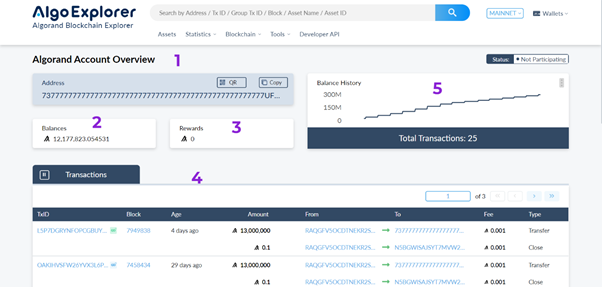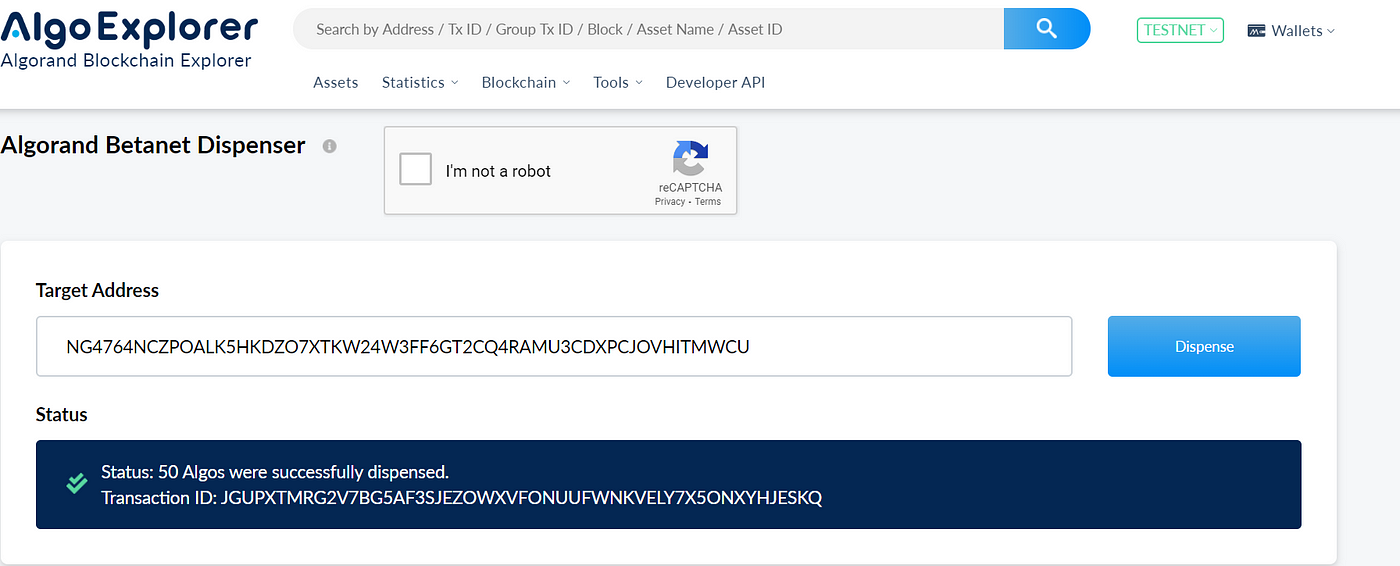In the world of internet technology, some tools or applications are ubiquitous and germane to our ability to use the internet. One of such tools is the browser. Internet browsers serve as the graphical user interface that connects us to all the complexities of software code and bits that are running on the internet applications that we use. It is useful for non-tech savvy persons who just to interact with web applications on their computers.
Similarly, blockchain projects store tonnes of fragmented information daily in the distributed ledger. Retrieving this information is technical and tedious. Most blockchains projects have community blockchain browsers, christened the blockchain explorer, which allows users to search the blockchain for historical information and generally how certain features work on the blockchain. The Algorand blockchain has at least two known blockchain explorers maintained by the community. However, and I am biased here, I will do a review of the AlgoExplorer, developed by
, which is well-known and well-designed Algorand explore. This review looks at the different sections of the Explorer and what they signify. Later, it will cover other Algorand explorers as well.
Part 1: The Algo Explorer — The landing page
This page is well segmented into sections summarising key actions on the chain. I numbered some of the important sections and will explain them starting from 1 to 10 as shown in the picture below.

{1} Search Box

The search box allows users to perform the following actions
· Search for information about an asset or token created on the Algorand chain
· Search for information relating to an Algorand address
· Retrieve specific block information by using with the block ID
· Lastly, searching by the transaction information using the Transaction ID (TxID).
{2} Latest Block

This section displays the ID of the latest block produced. This number is not static and changes every time a block is produced.
{3} Circulating Supply

This refers to the total Algorand token, called Algo, that is owned by the Algorand users (addresses) and can be traded or staked. It does not include any token that is locked away or frozen in any Algorand account.
{4} Total Supply

Unlike circulating supply, total supply refers to the total number of Algos generating participation rewards that are readily available to be used on chain
{5} Online Stake

This refers to the number of online Algos that are participating in the Algorand consensus. On Algorand, to be eligible to participate in consensus governance, the Algorand account needs to have at least 1 Algo and turn your account status online. The more tokens an account holds, the higher its chance of being selected to participate in consensus.
{6} Algo Price

This section displays the current market price of the Algo coin and how much it is traded at the various exchanges. It also shows the percentage of the 24hr change in the prices — the price seen on the section as compared to the same price 24hrs ago. Underneath the price is the Market Cap. This figure represents the total monetary value of the circulating token price. You can calculate this by multiplying the market price by the circulating supply at any given time.
{7} Block Tx Speed

Algorand prides itself in speed and scalability. So, this metric shows the average time it took to process each of the latest 10 blocks on the chain.
{8} Transactions History

Almost every 4 seconds a transaction block is produced on Algorand. This section displays the total transactions by date, month, and year. Users can sort using any of these parameters. You can also do a year-to-date comparison by click on the YTD link.
{9} Latest Blocks

This is a display of the latest Algorand block that was proposed in sequential order. You can view all blocks or the individual block using the lings provided
{10} Latest transactions

Like the latest blocks, latest transactions gives a summary of the latest transactions capturing 3 key parameters. The ID of the transaction. You can search this transaction details on the block by using the transaction ID. It also displays the sender and recipient addresses. You can as well view all transactions or click on the individual links to view more
{11} Mainnet/Testnet/Betanet

Algorand has different development stages: Betanet, Testnet and Mainnet. This section has a dropdown that allows the user to retrieve data from any of these protocols. Mainnet is the real-life data with actual transactions while Testnet is test transactions that users are making on the Testnet blockchain.
{12} Wallets

Algorand has both mobile and web wallets for managing your Algorand assets. When you click on the wallets drop-down, you find links to the web version of the wallet, Android and iOS versions for download
Part 2: The Algo Explorer — The Address page
This section features the display of relevant information about an Algorand address. A search of the explorer using the address returnS relevant information about the account. For this illustration, I will use the address: AXTW46L6EPL4V7XSJAR7X24ATUM4N43BA6HQT3IBG3RS6GZCOBJNR735NI

{1}, {2} & {3} Algorand account overview: Address, Balance & Rewards

The account overview section will display key metrics relating to the account. Obvious is the account address which was used to perform the search. Once you perform an address search, all relevant data displayed are related to the address and not the entire Algorand chain. Balance section refers to how many assets that account holds. I this instance, the account only has Algos but if there were any other assets owned by this account, they will display when the user clicks on the black dropdown arrow in the Balance box. Rewards refer to how much the account has earned by holding Algos in the wallet or account. Remember that Algorand gives daily rewards for holding Algos in your wallet.
{4} Transactions

As accounts perform transactions in any form, they are recorded in this section with more details about them. The important metrics here are the TxID (transaction ID) and Type (the transaction type). For developers, the TxID is used to retrieve all transaction details.
{5} Balance history

As you perform transactions, they are saved on the blockchain ledger. The AlgoExplorer simply displays the account balance over a period and the number of transactions the account has made.
{6} Status: Participating accounts

On Algorand, every account can participate in consensus governance and produce blocks. However, the account owner must first express interest to participate in the process. Accounts do this by switching their account status from Offline to Online. By default, all accounts are switched off when created.
{7} Status: Non-participating accounts

Accounts with this status do not earn Participation Rewards like the rest of the accounts and are not counted towards the Total Supply of Algos. All Non Participating accounts are mostly held by the Algorand Foundation. An example is the rewards pool address as shown in the picture above. It is funded by the Algorand Foundation and used to pay staking rewards.
Part 3: The Algorand Explorer Tools
Some tools allow the user to perform interactive tasks on the explorer. Below are details about some awesome tools on the AlgoExplorer
{1} Algorand Staking Rewards Calculator

For me, this is one of the coolest features on the AlgoExplorer. It provides a user interface to simulate your annual percentage rate of returns when you stake your Algorand tokens. Remember that, staking on Algorand is as simple as leaving your Algorand tokens in your wallet. For instance, if you left 67,000 Algos in your wallet for 1 year, you would earn 3, 955.44 Algos in return. It also gives a monthly and weekly breakdown. Remember that this only serves as a guide and is subject to change.
{2} Algorand Testnet Dispenser

The Algorand Testnet is a duplicate version of the main Algorand blockchain that allows developers and users to test their applications before pushing it live to the main blockchain. Transactions on Testnet still require users to have faux Algos to perform the transactions. So, one way of getting the faux Algorand tokens is to use the dispenser as shown here for your account to be credited with the tokens on the Testnet. AlgoExplorer allows users to do so easily. You first need to check that you are not a robot, past the address you wish to credit with the faux Algos and then click on the Dispense button. As seen below, the account is credited with 50 Algos. You can repeat the same process for the Betanet as well.
{3} Algorand Betanet Dispenser

Just like the betanet dispenser, developers can use this feature to credit an account with faux algos for testing your application on the betanet. Remember those tokens won’t work on the mainnet or testnet. They are useful only on the betanet for test transactions.
Part 4: Group Transactions

It is easy to perform group transactions on Algorand. To retrieve the group transaction details, perform a search using the transaction ID as shown in the example below.
There are 4 grouped transactions created in this transaction. Different amounts were transferred to different accounts simultaneously.
Part 5: Conclusion
This is a summary of the key features on the AlgoExplorer and I hope it has become easier to navigate the explorer after reviewing this. If anything changes or I got any part wrong, please draw my attention to it and I will correct it.



